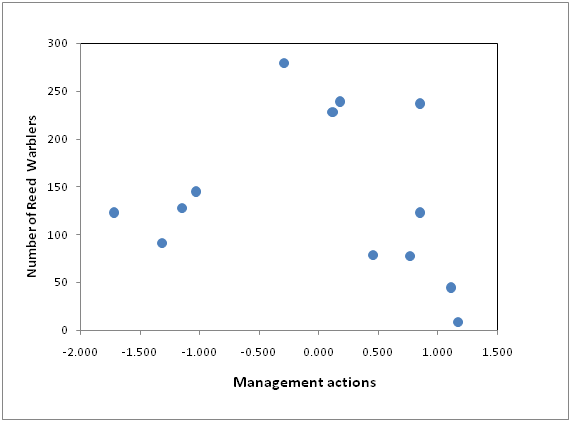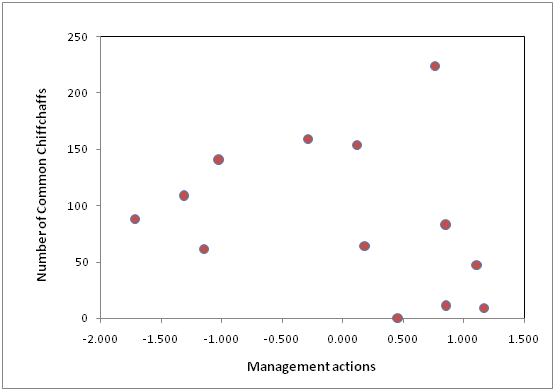International Journal of
eISSN: 2574-9862


Research Article Volume 3 Issue 6
Department of Ecology & Hydrology, University of Murcia, Spain
Correspondence: Ignacio García Peiró, Department of Ecology & Hydrology, Faculty of Biology, University of Murcia, Spain
Received: November 05, 2018 | Published: December 13, 2018
Citation: Peiró IG. No effects of water management resources on the abundance of two reed passerine birds in a semiarid Iberian Mediterranean reservoir. Int J Avian & Wildlife Biol. 2018;3(6):453-455. DOI: 10.15406/ijawb.2018.03.00140
Human-made wetlands immerse in semiarid lands may be subject matter of hydrological managements, which can be susceptible of climatic conditions in territories far of them, as is demonstrated in reservoirs dependent of the agricultural and human demands. Some reservoirs have a sufficient surface of mixed halophytic plants, which provide a critical and endangered small bird’s community. In this research, I explore if some management actions involve to the small dominant avifauna in a reservoir established in a semiarid zone of Iberian Peninsula (SE Spain). Results demonstrate that flood inputs, water levels and reed height after management do not influence precisely the abundances of summer warblers visitants as the Reed Warblers Acrocephalus scirpaceus or winter visitants as Chiffchaffs Phylloscopus collybita. Probably water channels input, with agriculture pollutants residuals, can alter the primary trophic chain and could be a primer factor influencing survival of adults and hence affecting the oscillations in the quantity of small passerines. Further investigations are required to check out which are the particular natural or artificial causes that significantly generate changes in the annual abundances of these or other representatives of the bird’s assemblage.
Keywords: management actions, reservoirs, small birds, agriculture, natural
Human-made wetlands like ponds, swamps or reservoirs can be subject matter of alterations in water levels due to climatic change1 or human-mediated processes.2,3 On the other hand, man-made actions on vegetation on such spaces may have a proximate or ultimate effect on the bird’s assemblage. The lack of hydric systems in semiarid Mediterranean sectors may be expected to be forced mainly to human mediated pratiques4 and to affect bird’s assemblages related to water bodies that may derivate in reductions of parameters of community towards a complete dropping of bird populations.5–8 In some passerines remarkably vulnerable on reed-beds the effect of lessening water levels by human-mediated processes may drive in the shortage of reed surface and the gradual recession of bird populations in some countries.9 On the other hand, the effect of some management activities (grazing, harvesting) can have a positive or negative effect of songbirds depending of space and time from the management operations.10
Climatic drought cycles is proved to have no effect on the quantity of the two most abundant reed passerine birds which fits the weight of the reed bird’s assemblage in terms of abundance and biomass.7,8,11 Particularly in a reservoir immerse in a fragmented landscape of intensive agriculture of Southwestern Spain (El Hondo Natural Park, Alicante province). The aim settled up in this investigation is to check out if man-made water management involves quantitatively to the gross of the passerine bird’s assemblage in this wetland.
Datasets were gathered from 1992 to 2004 (N = 13 years) in “El Hondo Natural Park”, an internationally appreciated and protected man-made reservoir in South-East Spain, inside a semiarid landscape with a highly fragmented and intensive agriculture. The following variables were taken: 1) The elevation of collected water in the reservoirs in terms of height of water in the reservoirs (m), 2) input water volume (Hm) deserved for irrigation from the aqueduct Tajo-Segura that was accessible at https://www.chsegura.es/chs/cuenca/infraestructuras/postrasvaseTajoSegura/historicos.html and 3) height of reed (cm) was obtained in situ after each management activity in the plots on where the birds were ringed11 and 4) annual amount of ringed birds of Reed Warblers Acrocephalus scirpaceus and Chiffchaffs Phylloscopus collybita collected by the author from Constant Effort Sites.11 The environmental variables (height of water, input water and height of reed) were statistically summarized by means a Principal Components Analysis (PCA) and later the factor scores of first eigenvalue were correlated with the annual ringing of the two most dominant passerines in El Hondo.11 Statistical data were analysed (PCA and Pearson’s correlations) using IBM SPSS Statistics v.23 statistical software.12
The proceeds of PCA (Table 1) produce three units on which PC1 receives the most eigenvalue and explained variance (66.14%). The first component describes a similar effect of the three management actions but an effective negative effect on reed height by the others, meaning that water sources are antagonists of the control activities effectuated on the reed (fires, cuttings, weed cutting). The annual number of Eurasian Reed Warblers and Common Chiffchaffs was weakly negative correlated with the management actions, indicating a not effect of management actions on its annual abundances (Figure 1 & 2).
Variable |
PC1 |
PC2 |
PC3 |
Water input |
0,72 |
0,7 |
0,00 |
Water level |
0,86 |
-0,29 |
0,43 |
Reed height |
-0,86 |
0,29 |
0,43 |
Eigen values |
1,99 |
0,65 |
0,36 |
% of variation |
66,2 |
21,77 |
12,07 |
Table 1 PCA analysis of management actions (water input, water level and reed height). PCA Axes (PC1, PC2 and PC3) eigenvalues and independent percentage of variation are given

Figure 1 Weakly negative correlation among management actions, expressed as factor scores of the first PCA (PC1, Table 1) and the annual number of Eurasian Reed Warblers ringed. Pearson’s correlation, r=- 0.175; p=0.567; d.f = 13.

Figure 2 Weakly negative correlation among management actions, expressed as factor scores of the first PCA (PC1, Table 1) and the annual number of Common Chiffchaffs ringed. Pearson’s correlation, r=- 0.263; p=0.386; d.f = 13.
This short research finds out that the direct supply of water input does not alter the gross of two small passerine birds referred to the interphase water-vegetation in eutrophic wetlands.13 Management plans have a weak negative effect giving up a lessening the abundance of annual ringing results. Bird’s assemblages in wetlands are affected differentially by human actions.14 In this sense, the water quality, here not analyzed, depends immediately of irrigation channels and might be a serious and convincing component in the input of pollutants produced in the agriculture management.15–29 This indirectly could change the trophic chain and the bird’s assemblages established at the reservoirs16,17 because of some threatened small birds forage on insects and other aquatic invertebrates as available food in the surface of the water.18,19 Again, mud collected in the ground of the reservoirs due eutrophication20 can modify the primary stages of the food chain due to the overpopulation of invasive species21,22 which are food on endangered waterbirds getting bacterial infections by, for example, Clostridium botulinum (botulism:23–25) and lead poisoning in the mud can create episodes of plumbism.26–28 In conclusion, although management actions had not effect on the ringing abundances of the two most abundant small birds of the assemblage, this effect could have a strong effect on the other, more sensitive species of the assemblage, needing future studies to be analyzed. Additionally, more research is needed to assess which are the abiotic or biotic sources of the oscillations in the abundance of passerine birds settled permanently or temporally in the reservoirs.31
I must thank to the Comunidad de Riegos de Levante and Generalitat Valenciana for provide me the permits to entry and to ring birds at El Hondo Natural Park during the previous years. D. Jose Antonio Sánchez (Comunidad de Riegos de Levante) afforded me with the water levels data. I thank the Reviewers of peers in the improvement of earlier versions.
Author declares that there is no conflict of interest.

©2018 Peiró. This is an open access article distributed under the terms of the, which permits unrestricted use, distribution, and build upon your work non-commercially.